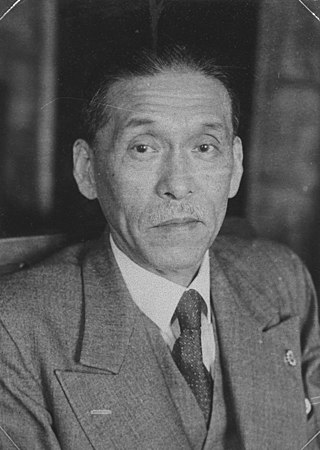Hitoshi Ashida
Prime Minister of Japan in 1948 From Wikipedia, the free encyclopedia
Hitoshi Ashida (芦田 均, Ashida Hitoshi, 15 November 1887 – 20 June 1959) was a Japanese politician who served as Prime Minister of Japan in 1948. He was a prominent figure in the immediate postwar political landscape, but was forced to resign his leadership responsibilities after a corruption scandal (Shōwa Denkō Jiken) targeting two of his cabinet ministers.
Hitoshi Ashida | |
|---|---|
芦田 均 | |
 Official portrait, 1948 | |
| Prime Minister of Japan | |
| In office 10 March 1948 – 15 October 1948 | |
| Monarch | Hirohito |
| Governor | Douglas MacArthur |
| Deputy | Suehiro Nishio |
| Preceded by | Tetsu Katayama |
| Succeeded by | Shigeru Yoshida |
| Minister for Foreign Affairs | |
| In office 1 June 1947 – 15 October 1948 | |
| Prime Minister | Tetsu Katayama Himself |
| Preceded by | Tetsu Katayama (acting) |
| Succeeded by | Shigeru Yoshida |
| Deputy Prime Minister of Japan | |
| In office 1 June 1947 – 10 March 1948 | |
| Prime Minister | Tetsu Katayama |
| Preceded by | Kijūrō Shidehara |
| Succeeded by | Suehiro Nishio |
| Minister of Health and Welfare | |
| In office 9 October 1945 – 22 May 1946 | |
| Prime Minister | Kijūrō Shidehara |
| Preceded by | Kenzō Matsumura |
| Succeeded by | Yoshinari Kawai |
| Member of the House of Representatives | |
| In office 21 February 1932 – 20 June 1959 | |
| Constituency | Kyoto 3rd (1932–1946) Kyoto at-large (1946–1947) Kyoto 2nd (1947–1959) |
| Personal details | |
| Born | 15 November 1887 Fukuchiyama, Kyoto, Japan |
| Died | 20 June 1959 (aged 71) Minato, Tokyo, Japan |
| Political party | LDP (1955–1959) |
| Other political affiliations | Rikken Seiyūkai (before 1940) IRAA (1940–1945) JLP (1945–1947) DP (1947–1950) NDP (1950–1952) Kaishintō (1952–1954) JDP (1954–1955) |
| Spouse |
Sumi Hase (m. 1918) |
| Alma mater | Tokyo Imperial University |
| Signature |  |
Early life and education

Ashida was born in Fukuchiyama, Kyoto, the second son of politician and banker Shikanosuke Ashida.[1] His father had been in the House of Representatives and served as director of Nōkō Bank. His grandfather was landed magnate and village headman (nanushi) Jizaemon Ashida.[2]
He studied French civil law at Tokyo Imperial University. After graduation, he worked in the Ministry of Foreign Affairs for twenty years.
Political career
In 1932, Ashida ran his first successful campaign for a seat in the House of Representatives as a member of the Seiyūkai Party. He sided with Ichirō Hatoyama's "orthodox" wing following the Seiyukai's split in 1939.
After the war, Ashida won a seat in the new Diet as a member of the Liberal Party, from which he split to merge with Kijūrō Shidehara's Progressive Party to form the Democratic Party. Ashida was elected president of the new party, and became minister of foreign affairs in 1947 under Socialist prime minister Tetsu Katayama.
He also chaired the Committee on the Bill for Revision of the Imperial Constitution, and served as the chairman of the Kenpō Fukyū Kai, a society created to promote the revised Constitution of Japan, from 1946 to 1948.[3][4] During his term, he made a key amendment to Article Nine of the planned Japanese Constitution, which enabled the creation of the Japanese Self-Defense Force.[5]
Premiership (1948)

Ashida became prime minister in 1948, leading a coalition government of Democratic and Socialist members. His tenure ended just seven months after it began. Two of his cabinet ministers were accused of corruption in the Showa Electric scandal, which forced the cabinet to resign.[6] One of them was Takeo Kurusu, a state minister without a portfolio.[7]
Ashida's government was hampered by taking over at the end of the fiscal year. The country operated on a temporary budget until a budget was passed in July.[8]
Later life
After his tenure as prime minister, Ashida focused on Japan's position in Asia and re-armament. He became outspoken in support of creating a national defense force after the outbreak of the Korean War, fearing that a similar conflict may occur in Japan. Ashida also promoted the idea of forming a Japanese group of volunteers to fight alongside United Nations Command in support of the Republic of Korea. In 1951, he gave speaking tours across Japan advocating for his interpretation of Article 9, stating that it does not impose restrictions on Japan preparing a force for defensive purposes.[9]
In 1958, Ashida was cleared of all charges in relation to corruption allegations. He died a year later at the age of seventy-one.
References
Works cited
External links
Wikiwand - on
Seamless Wikipedia browsing. On steroids.
